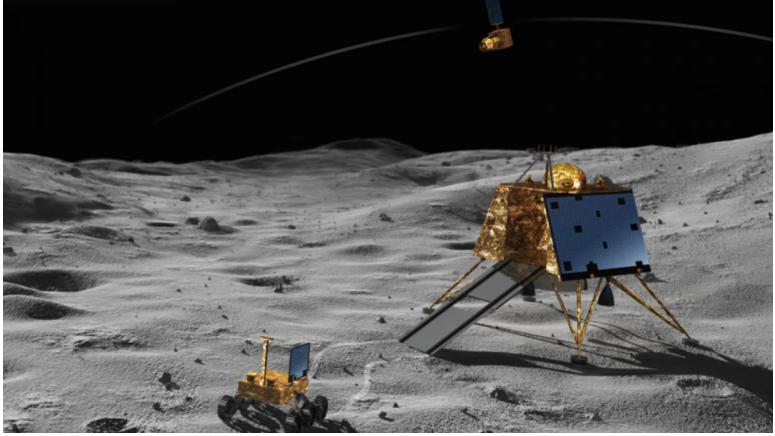Chandrayaan-2: Nasa lunar orbiter to fly over Vikram landing site, take photos in new attempt to spot lander

A lunar rover operated by the United States is scheduled to fly over the landing site of the Chandrayaan-2 lander Vikram sometime on Monday. Communication with Vikram was lost during the Chandrayaan-2 lander's attempt to land on the Moon on September 7. Vikram is likely dead now after a cold lunar night during which its instruments were probably frozen out of operation.
This is the second time the Lunar Reconnaissance Orbiter -- operated by the US space agency National Aeronautics and Space Administration -- will fly over Vikram's landing site and attempt to take pictures. The LRO previously flew over Vikram's landing site on September 17 (10 days after the lander lost contact) and took pictures of the area.
However, the photographs were shot at a time when it was dusk in the south polar region of the Moon where Vikram attempted landing, and so, the Chandrayaan-2 lander was not clearly visible in the images. Then, Nasa had indicated that Vikram could be hiding in the long shadows present on the lunar surface.
Nasa had also said that its LRO would fly over Vikram's landing site again on October 14. Lighting conditions during the LRO's second fly-past over Vikram's landing site are expected to be better than on September 17 and so, could offer clues about the Chandrayaan-2 lander's physical condition.
LANDING ATTEMPT GONE AWRY
Vikram attempted landing on the Moon on September 7 as part of the Chandrayaan-2 mission's grand dream of placing a rover on the Moon. Vikram housed the six-wheeled rover Pragyaan, which, if things had gone according to plan, would have explored the lunar surface for one lunar day, equivalent to 14 Earth days.
Initially, Vikram's 15-minute lunar descent went according to plan. However, moments before Vikram was to land on the Moon, it went silent and the Indian Space Research Organisation lost all contact with the Chandrayaan-2 lander.
 Vikram with the six-wheeled rover Pragyaan (Photo: Isro)
Vikram with the six-wheeled rover Pragyaan (Photo: Isro)
Since then, Vikram has not been heard from and we still do not know what exactly went wrong. However, according to an India Today Magazine report based on data and readings gathered from the lunar descent, Vikram inexplicably performed a somersault during its landing attempt.
And so, Vikram's reverse thrust-producing engines briefly pointed skyward. According to the report, what this meant was that the engines, located on Vikram's belly, instead of slowing the craft down propelled it towards the lunar surface. It was around this time communication with Vikram was lost.
EFFORTS TO MAKE CONTACT
After losing contact with Vikram, Isro began intense efforts to re-establish communication with the Chandrayaan-2 lander. However, days passed without any success.
The US space agency Nasa too lent help. Apart from deploying its ground-based communication satellites to attempt talking to Vikram, Nasa also sent its Lunar Reconnaissance Orbiter to fly over the Chandrayaan-2 lander's landing site.

Nasa's LRO was previously unable to spot Vikram due to long shadows and low light on the Moon (Photo: Nasa)
The LRO flew over the landing site on September 17 and took photos. However, the south polar region of the Moon where Vikram attempted landing was covered in dusk by then. The low light and the long shadows on the lunar surface made it difficult to spot Vikram.
That hopefully will not be the case when the LRO attempts its second fly-by on Monday.
LUNAR NIGHT
Even if the LRO manages to spot Vikram, chances of establishing communication with the lander are next to none. Vikram is already past its original mission life of one lunar day, or 14 Earth days.
Also, the region of the Moon where Vikram attempted landing has just come out of a cold lunar night (which lasted around 14 Earth days). Nightime temperatures in the region can plunge to below minus 200 degrees Celsius.
Vikram or Pragyaan did not have any onboard heating apparatus and so, their instruments are likely to have been frozen out of operation during the lunar night, which means that re-establishing contact with the Chandrayaan-2 lander is unlikely.
CHANDRAYAAN-2 ORBITER
The Chandrayaan-2 mission also consisted of an orbiter that is safely orbiting the Moon right now. Isro has been able to extend the orbiter's mission life from the original one year to seven years. Not only is the orbiter functioning perfectly, it has also begun carrying out the many experiments it is supposed to.

The Chandrayaan-2 orbiter recently sent high-res photos of the lunar surface (Photo: Isro)
In the last few days, the orbiter has detected solar flares from the Sun and charged particles near the surface of the Moon. Both of these findings will ultimately help the orbiter test for the presence of various elements on the Moon's surface.
The orbiter has also sent back high-resolution photos of the lunar surface. The photos will play an important role in helping Isro analyse the Moon's surface.
As for as Vikram... we should know more in the upcoming days once Nasa goes public with the new photos its LRO has shot of the Chandrayaan-2 lander's landing site.
Source: https://www.indiatoday.in/science/story/chandrayaan-2-nasa-lunar-orbiter-vikram-landing-site-photos-new-attempt-1609280-2019-10-14





























































Comments
Test name February 19, 2016 Reply
There are many variations of passages of Lorem Ipsum available, but the majority have suffered alteration in some form, by injected humour, or randomised words which don't look even slightly believable. If you are going to use a passage of Lorem Ipsum, you need to be sure there isn't anything embarrassing hidden in the middle of text.
Test name February 19, 2016
Lorem ipsum dolor sit amet, consectetur adipiscing elit, sed do eiusmod tempor incididunt ut labore et dolore magna aliqua.
Test name February 19, 2016Reply
Lorem ipsum dolor sit amet, consectetur adipiscing elit, sed do eiusmod tempor incididunt ut labore et dolore magna aliqua. Lorem ipsum dolor sit amet, consectetur adipiscing elit, sed do eiusmod tempor incididunt ut labore et dolore magna aliqua.